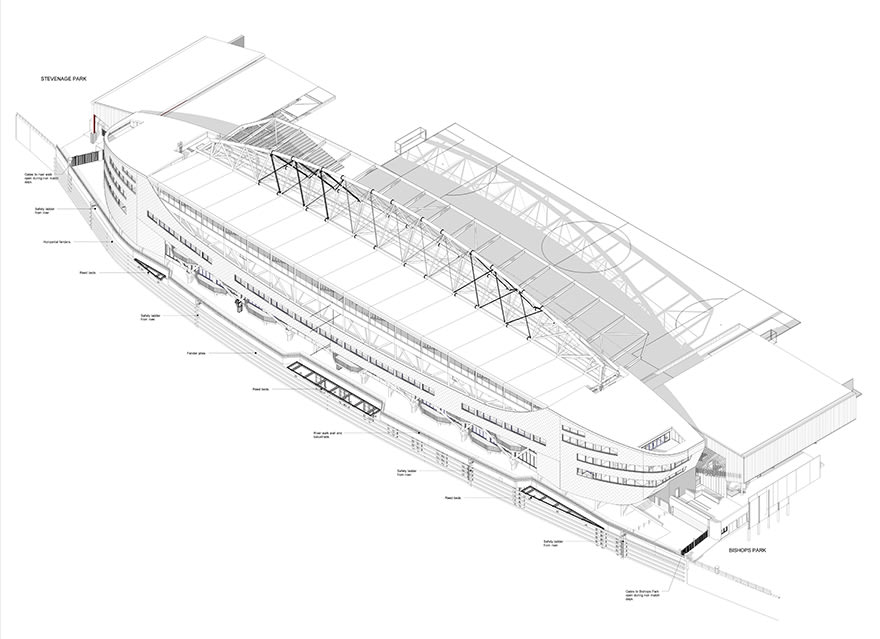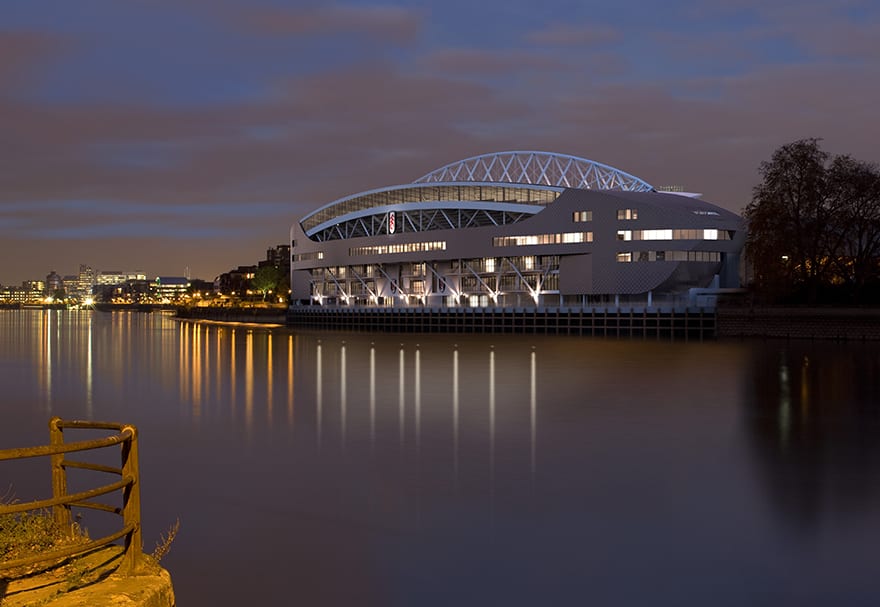- Client: Fulham FC
- BIM Tools: Autodesk Revit
In 2011 Fulham Football Club approached KSS to carry out a feasibility study with the aim of increasing the club’s capacity at its stadium, Craven Cottage, from 25,000 to 30,000.
Increasing the size of the stadium presented a challenge as the building stands on an extremely constrained site in west London, bounded by residential buildings, a park and the River Thames. The grade II-listed Johnny Haynes Stand, dating from 1896, to the east of the site, was to be retained and the proximity of the boundaries to the north and south meant developing these areas was not feasible.
This meant the west stand, backing directly onto the river, was deemed to have the most potential for development. So the architects were challenged to optimise both the capacity and the football club’s desired facilities that could be squeezed on the narrow site between the river and the edge of the existing pitch.
KSS models all the stadiums it designs in 3D using Autodesk Revit, and in this case it combined its work with the structural and services designs by WSP in a federated model.
“We’ve been working in Revit for 11 years and it’s now the software of choice in the office,” says Will Ardill, technical director at KSS. “We don’t use 2D CAD any more – we only use AutoCAD now for early sketch proposals and detail studies and as a tool to support 2D drafting within the Revit environment.”

The model was used to create verified views and explain the planned expansion during the planning process
According to Ardill the complexity of the stadium means that there are obvious benefits to using BIM. “There were many benefits gained upfront due to the complex geometry of the stadium and the challenge of rigging seating tiers above accommodation, which means you are rarely working with regular shaped spaces and horizontal soffits,” he says. “The ability to cut and analyse sections through these spaces is invaluable.”
BIM was also an essential tool for WSP to position the services within the building, says Ardill: “The narrow site meant that there was a lot happening in one place, finding an optimum route for the services and amenities was a massive benefit of the BIM model.”
As part of the development of the stand, the Thames river walk will be extended, creating an accessible public area in front of the new west stand for use on non-match days. This meant that a new marine wall was designed to extend the existing external concourse further into the river.
WSP, which was also working with Revit, additionally acted as the marine engineer on the scheme and provided BIM information on both the existing and proposed marine wall that was fed into the federated model.

Along with coordination of design the BIM model was also invaluable in accurately presenting information to the club
Along with coordination of design the BIM model was also invaluable in accurately presenting information to the club. As different options were explored, it was possible to quickly extract information on schedules, capacity and seating options from the model.
“Life is made easier when the design changes as we have a 3D model. We are able to alter the design and present options in a way that is clear and easily understandable to the client. BIM certainly helps clients understand what they are getting,” says Ardill.
Being able to easily present the design and communicate ideas was especially useful at Fulham as the client changed midway through the design process when Mohamed Al Fayed sold the football club to American businessman Shahid Khan.
As the site is in such a prominent riverside location, the architect points out that along with the client there were a lot of people in Fulham and users of the river who wanted to be kept abreast of the project.
The model was also used to create verified views and explain the planned expansion during the planning process as well as being used as the basis for various studies related to the use of the river by the local sailing clubs.
The stadium, which was granted full planning approval in 2012, is due to start on site early next year.
There were many benefits gained upfront due to the complex geometry of the stadium and the challenge of rigging seating tiers above accommodation, which means you are rarely working with regular shaped spaces and horizontal soffits.– Will Ardill, technical director, KSS
Comments
Comments are closed.












Excellent this is a new era of technology